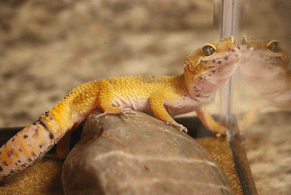Common leopard geckos are great beginner lizards for new reptile and lizard owners. Their ease of handling and minimal care makes them a good pet lizard for beginners. You can find a lot of good information on the internet about leopard geckos and what to expect.
This article gives lots of information for owning and enjoying a common leopard gecko and includes suggestions for choosing a tank, caring for and feeding a leopard gecko and how to create an amazing life together.
What Kind of Tank Does a Leopard Gecko Need?
One nice thing about owning a common leopard gecko is that their habitat doesn’t have to be big, so no matter the size of the home, anyone can care for them. If you are looking for a leopard gecko habitat you can find one at Petco.
First priority is their habitat. Although they don’t need a huge tank, the right temperature is very important. Ideally, you should keep the temperature around 75 to 85 degrees Fahrenheit. Leopard geckos can’t tolerate temperatures lower than 50 degrees Fahrenheit. However, they also love to have a place to bask in the sun at a maximum temperature of 95 degrees Fahrenheit.
Fill their tank with rocky, clay-gravel soil, then cover with a layer of sand. This allows them to burrow and find shade, depending on the time of the day.
How Often Should a Leopard Gecko’s Tank Be Cleaned?
 It’s important to keep your leopard gecko’s tank clean, especially when your leopard gecko is done shedding. You should clean your pet’s tank every [how often?] and remove any leopard gecko morphs from shedding. First, move your leopard gecko to a secure location. Then you can remove everything in the habitat, like rocks, trees, leaves, etc. You will want to scrub the tank clean with a reptile habitat cleaner. You can also use a 3% bleach solution. Be sure to fully rinse the tank out after scrubbing it. Once everything is fully dried, you can begin to reassemble the tank and return your leopard gecko.
It’s important to keep your leopard gecko’s tank clean, especially when your leopard gecko is done shedding. You should clean your pet’s tank every [how often?] and remove any leopard gecko morphs from shedding. First, move your leopard gecko to a secure location. Then you can remove everything in the habitat, like rocks, trees, leaves, etc. You will want to scrub the tank clean with a reptile habitat cleaner. You can also use a 3% bleach solution. Be sure to fully rinse the tank out after scrubbing it. Once everything is fully dried, you can begin to reassemble the tank and return your leopard gecko.
What Do Leopard Geckos Eat?
A well-balanced diet for your leopard gecko includes a variety of insects like include crickets, roaches, mealworms, calciworms or small locusts. If you are going to give them crickets, make sure they were recently fed and are no larger than the space between your leopard gecko’s eyes. Hunting for their food, even in their tank, also makes for a happier, healthier gecko. Plus, it’s quite entertaining to watch them hunt and catch their food. If you aren’t able to find living insects, you can purchase freeze-dried insects. But then you need to also purchase additional nutrients and supplements. Check with a vet for the best advice.
There are a few more things you’ll want to keep in mind. Only offer the insects to your gecko one or two at a time. You want to make sure that every single one is eaten before attempting to feed them another. If your leopard gecko leaves food in the tank after eating, remove it. If you don’t, any insects that remain will begin to eat your gecko’s skin and cause harm to them. Always have clean, fresh water for your leopard gecko.
How Often Do Leopard Geckos Eat?
 You’re probably wondering how often you should feed your leopard gecko. It depends on the age of your pet, something you’ll want to check out when you buy your leopard gecko. A leopard gecko that is 12 months or younger is considered a juvenile or baby. Anything older than 12 months is considered an adult. If you aren’t sure the age of your leopard gecko and don’t have anyone to ask, weigh your new friend. An adult leopard gecko weighs around 40 grams, juveniles weigh less.
You’re probably wondering how often you should feed your leopard gecko. It depends on the age of your pet, something you’ll want to check out when you buy your leopard gecko. A leopard gecko that is 12 months or younger is considered a juvenile or baby. Anything older than 12 months is considered an adult. If you aren’t sure the age of your leopard gecko and don’t have anyone to ask, weigh your new friend. An adult leopard gecko weighs around 40 grams, juveniles weigh less.
For juvenile leopard geckos, you should feed them every single day, around five to seven small insects at every feeding. Once your leopard gecko has reached adulthood, their diet will change to feeding them every other day or two to three times a week, giving them six to seven large insects at every feeding.
How Long Can a Leopard Gecko Go Without Eating?
You may notice that your leopard gecko won’t eat for a few days, which is common. Most adult leopard geckos can go anywhere from 10 days to two weeks without eating. This is because leopard geckos store a lot of their fat in their tail, which allows them to go for long periods without eating. However, a juvenile leopard gecko should eat more frequently. You shouldn’t go more than 10 days without feeding a juvenile leopard gecko.
You should always keep an eye on your leopard gecko and make sure that they aren’t refusing to eat due to illness or improper care. If you see any changes in behavior you should get them checked out. Besides food consumption, make sure your leopard gecko doesn’t go more than three days without drinking water, so they don’t get dehydrated and die.
How Long Do Leopard Geckos Live?
The lifespan of most leopard geckos is anywhere from 10 to 20 years. The length of time your pet leopard gecko lives ultimately comes down to your care of them. Owning one of these fellows is a long-term commitment, something you should take into account when deciding on a pet lizard. Interestingly enough, in the wild, leopard geckos will only live between six to eight years, with females living shorter lives than males. So, if you take care of your new pet they will live a long and healthy life.
If you’re interested in learning about other reptiles, check out our reptile page. There is lots of information on many different kinds of reptiles, their habitat and care.


